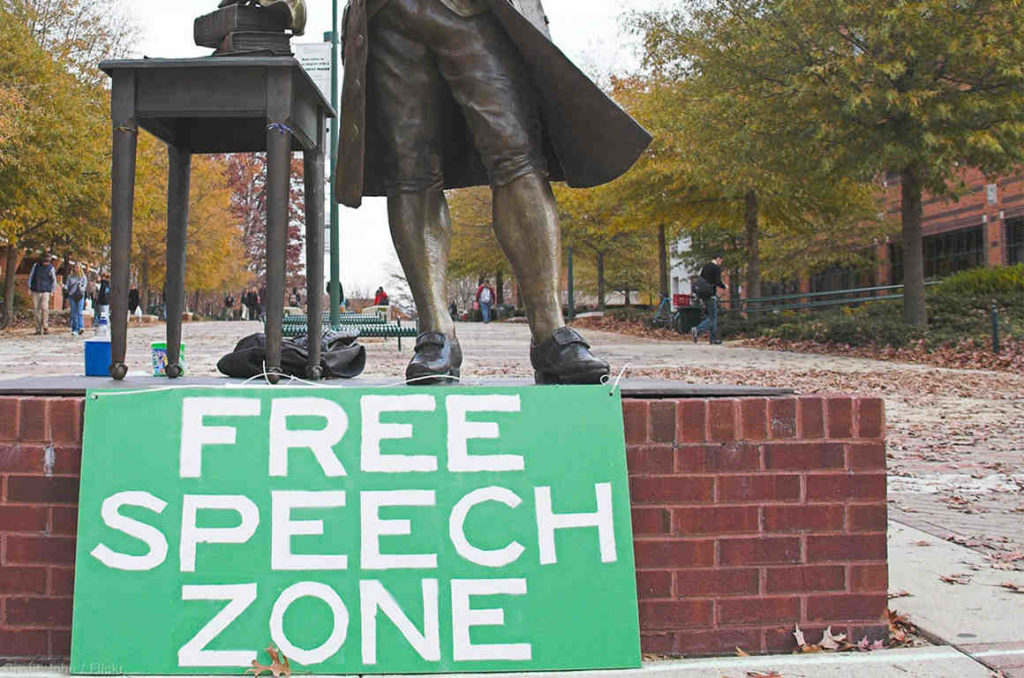Free speech has been under threat on American college campuses for some time. Ostensibly bastions of debate and rational inquiry, colleges and universities are seeing increasing numbers of college students who report fear about speaking their mind lest their thoughts be labeled “hate speech.” As a result, more and more college administrators and policymakers are sounding the alarm.
These phenomena spawned an effort by the Bipartisan Policy Center (BPC) to convene a taskforce to deal with the emerging threat. The endeavor culminated in a report released in November advising college administration, staff, and faculty on ways in which they could reasonably manage issues surrounding free speech on campuses. On February 9, the Bipartisan Policy Center’s Campus Free Expression Project, together with Baptist General Convention of Texas-affiliated Baylor University’s Baylor in Washington, D.C. program, co-hosted a panel discussing the results of the report.
The panel, which was moderated by Baylor Political Philosophy professor and author of The Just War Tradition: An Introduction David Corey, featured such speakers as former Governor Christine Gregoire (D-WA), as well as Baylor University President Linda A. Livingstone and Concordia College – New York President and Lutheran Church – Missouri Synod minister John Nunes.
According to the panelists, the report provides specific, actionable items for university administrators to undertake in seeking to improve free speech conditions in campus life. These items are built around the purpose of instilling a particular sense of the campus’ culture and what that means for free expression.
This is a particular problem for students. As Nunes pointed out, “most of the students at most colleges and/or universities come from extremely homogeneous high schools and backgrounds, and their college experience, often, is the first time they have this kind of encounter with people from international and diverse backgrounds, and with a diversity of perspectives.”
Nunes also warned that students today are more likely to have a negative reaction to cultures of free expression than students in the past. “Not only are our students unprepared…to have these conversations,” he said, “they’re ill-prepared or mal-prepared by social media, where the impulse response leads to a deterioration of any sort of listening or any humility in these conversations.”
As for how to address the problem, Livingstone mentioned that “one of the very specific recommendations” of the BPC report “is to think about what we do in freshman orientation. As students come to our campus, are we doing things in freshman orientation to help them understand that part of the college experience is to be challenged in your thinking and to learn how to listen, learn, and articulate very clearly what you believe?”
Gregoire, meanwhile, noted that issues regarding the importance of free speech are not only limited to students: “the same can be true of our professors,” she said. “Are they comfortable having this kind of open dialogue with their students? Can we help them go through a couple of exercises where they become more comfortable and are more open and can handle the situation better themselves?”
Corey was interested in the underlying factors of why students and professors were cautious to support free speech. “Freedom of speech is an age-old liberal value,” he began, “but…it seems every generation, it comes into tension with some other good.”
Livingstone answered that the problem for most students is the supposition “that free expression is in conflict with diversity, equity, and inclusion (DEI) rules.” Nunes responded by saying that while there certainly can be conflict between the two values of free expression and DEI, oftentimes, the two support one another. He stated that “freedom of expression, over the long haul especially, protects the rights and safety especially of underrepresented minorities, in terms of…their voice at the table.”
Of course, one may wonder whether these principles can actually succeed in fighting the onslaught against free expression on college campuses. Still, the panelists were generally optimistic. Nunes, in particular, shared a story about athletes who wanted to protest on behalf of racial justice issues by kneeling during the national anthem.
To address the issue, Nunes “initiated a series of campus-wide conversations…in which” he “brought together people from a variety of backgrounds.” The result? “At the end of the day,” Nunes concluded, “we took some initiatives on campus that dealt with racial justice issues, and, at the end of the day, no students kneeled.”
Time will tell whether this strategy can be replicated across other campuses. But if freedom of speech is to thrive in America in the years ahead, it will need to be culturally accepted among the next generation. And if many of our youngest students on college campuses fail to acclimate to a tolerance for free expression, then dark times may lie ahead for its survival.






Comment by Remember marxism is a religion on February 15, 2022 at 9:20 am
Without a ‘religious revolution’ there is going back on the attack of the left on free speech.
It is not news that Marxist thought is really a poor shirt to put on what is in essence a religion. Marx’s theory is more unbelievable than Star Wars, yet these days the academy wears the hair shirt of Marxism like a soft Under Armor Heat Wear undershirt because it gives their followers something to believe in other than nihilism.
I’m not in the academy anymore, but to those who are, be brave and fight the good fight for God’s sake.